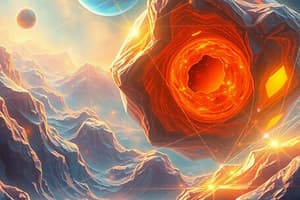Podcast
Questions and Answers
What ions do acids release into water?
What ions do acids release into water?
Hydrogen ions
What ions do bases release into water?
What ions do bases release into water?
Hydroxide ions
What is the result when acids and bases react?
What is the result when acids and bases react?
Salt and water
What is the pH of a neutral solution?
What is the pH of a neutral solution?
What color does red litmus paper turn in the presence of acids?
What color does red litmus paper turn in the presence of acids?
What are the properties of acids?
What are the properties of acids?
List the properties of bases.
List the properties of bases.
What happens in a neutralization reaction?
What happens in a neutralization reaction?
Give an example of a neutralization reaction.
Give an example of a neutralization reaction.
How are salts formed?
How are salts formed?
Flashcards are hidden until you start studying
Study Notes
Acids, Bases, and Salts in Class 7: A Journey Through Chemistry's Building Blocks
Acids and Their Properties
In Class 7, you'll learn that acids are substances that release hydrogen ions (H⁺) when dissolved in water. They have a sour taste and can turn red litmus paper red. Acids like citric acid, hydrochloric acid, and sulfuric acid play an essential role in everyday life, from cleaning to digestion.
Acids exhibit the following properties:
- Sour taste due to the presence of hydrogen ions.
- Turn red litmus paper red.
- React with bases to form salts.
- Release hydrogen gas upon reaction with metals.
Bases and Their Properties
Bases, on the other hand, are substances that release hydroxide ions (OH⁻) when dissolved in water. They have a soapy feel and taste bitter when dissolved. Sodium hydroxide, potassium hydroxide, and calcium hydroxide are common examples of bases.
Bases exhibit the following properties:
- Soapy feel.
- Turn blue litmus paper blue.
- Neutralize acids to form salts.
- React with acids to release water and form salts.
Neutralization Reactions
When an acid reacts with a base, a neutralization reaction occurs, forming a salt and water. For example, when hydrochloric acid and sodium hydroxide are mixed, sodium chloride and water are produced.
Common Salts
Salts are formed from the neutralization of acids and bases. Some common salts include sodium chloride (from hydrochloric acid and sodium hydroxide), sodium sulfate (from sulfuric acid and sodium hydroxide), and potassium nitrate (from nitric acid and potassium hydroxide).
Simplifying the Science
Think of acids as those substances that release hydrogen ions, making the water around them more acidic. Bases, in contrast, release hydroxide ions, making the water around them more basic. When acids and bases meet, they swap their ions and form a salt. The water that results from this reaction is neutral, neither acidic nor basic.
So remember, acids turn red litmus paper red, bases turn blue litmus paper blue, and their combination results in a salt and water. And don't forget that a pH of 7 indicates a neutral solution. did not provide scientific information relevant to the topics outlined above, so they were not utilized in the creation of this article.
Studying That Suits You
Use AI to generate personalized quizzes and flashcards to suit your learning preferences.




